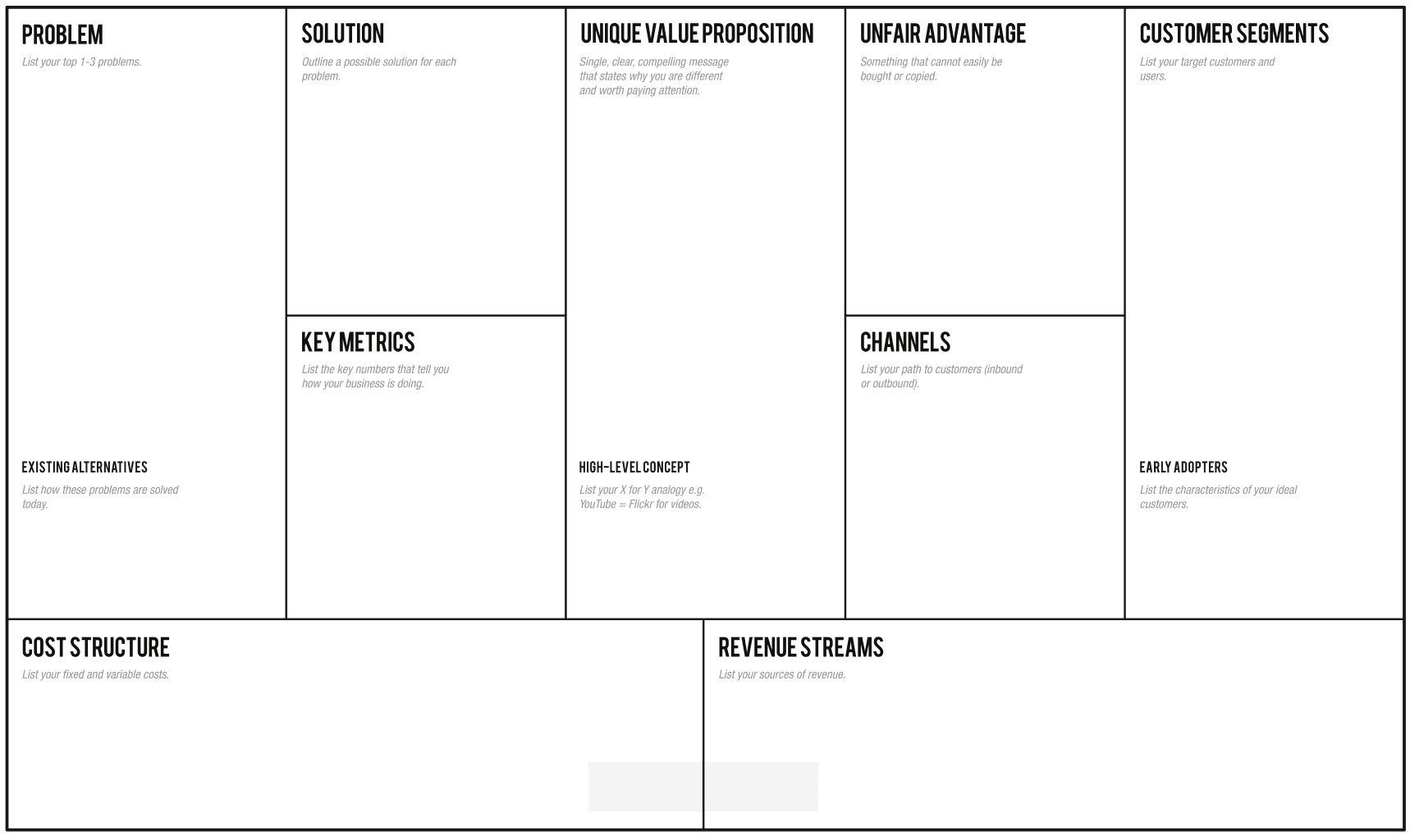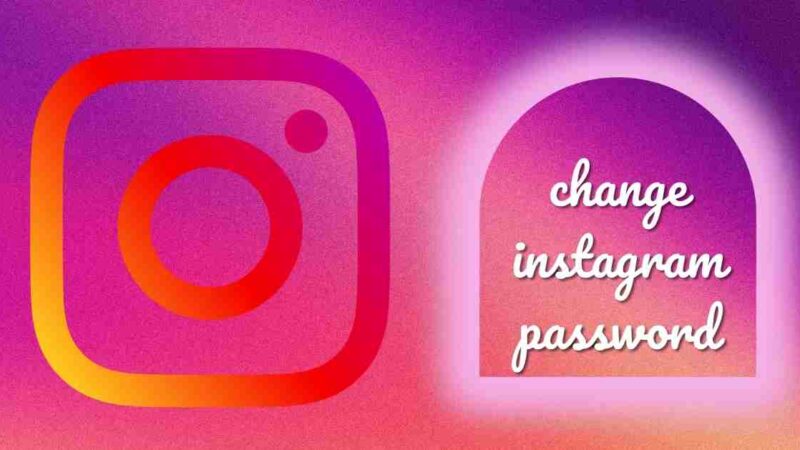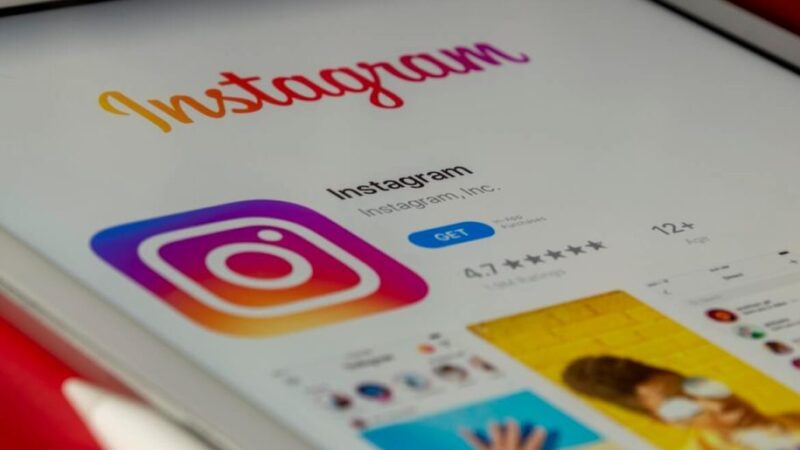Lean Canvas What is it? How does it work? Step by step

When you have a business idea, the first question you ask is how do you develop a business model? Because materializing an idea to a real business, it is a long and extensive process, where it is necessary to analyze the profitability and viability, it is important to collect data, analyze and create a solution or product.
The lean canvas is an adaptation of the Business Model Canvas, developed in 2008 by Alexander Osterwalder and Yves Pigneur, but it was Ash Maurya, who combined the elements of the traditional business model and developed what we now know as lean canvas. It proposes a template for the evaluation of the business model and strategic management.
Table of Contents
What is Lean Canvas?
It is a canvas used by entrepreneurs since it allows to know, explore and test a new business model, this allows to obtain an overview of the market, however, this model gives the opportunity to entrepreneurs to pivot and improve their version every day, managing to obtain a solid and consolidated model.
This canvas is divided into 9 sections that are: problem, solution, key metrics, unique value proposition, special advantage, channels, customer segments, cost structure, and source of income.
In order to collect the information of the 9 sections, it is necessary to know that it has a classification among them that are:
- The unique value proposition is located in the central part of the canvas, where the idea of the business is analyzed in detail.
- The right side of the canvas is used to describe, know and analyze the market, here you will find the sections of the problem, solution, key metrics, and cost structure.
- The left side of the canvas is used for the analysis, evaluation, and development of own products and services, here is a special advantage, customer segments, channels, and source of income.
Bases del Lean Canvas
In the book, The Lean Startup by Eric Ries, points out 3 fundamental bases for the development of products, launch, evaluation, and improvements obtained, therefore, it is one of the foundations that supports the creation of the Lean Canvas, where, it is a tool to lay the idea and evaluate the viability of a possible business model, the elements are the following:
- Create: develop a product or solution, prototype style (MVP – Minimum Viable Product), which allows you to evaluate with your first customers (early adopters).
- Measure: check the reaction and opinions that the first customers have about the product.
- Learning: with the results obtained, the relevant improvements are made and pivoted again, until the point of balance between quality and benefits is found.
Differences between Business Model Canvas and Lean Canvas
Both models are very similar, the only thing is that Lean Canvas is an adaptation and variation of the Business Model Canvas created by Alexander and Yves.
The main difference between the two is that the business model canvas focuses on companies and business models already consolidated and active, where it already has a portfolio of customers and business partners. Unlike Lean Canvas that focuses on piloting and testing a new business model, often used by entrepreneurs or startups.
Some differences between the boxes are that the Lean Canvas replaces the problems with key partners, the solution by key activities, the competitive advantage by customer relationships, the key metrics by resources, the single value proposition by a clear value proposition.
Benefits of using Lean Canvas
- Identifies weaknesses and strengths of the business model.
- Evaluate and know the opportunities offered by the current market.
- Reinforce the development of products or services offered.
- Evaluate the profitability of the business model.
- Draw up strategies for the company.
- It allows to reformulate the ideas and adapt to the reality of the market.
Step by step to fill the lean canvas
I invite you to download the template, since I will be explaining the steps to complete the canvas, it is necessary to fill the boxes according to the order that is recommended:
- The problem and the customer segment.
- Single value proposition.
- solution.
- canals.
- Cost structure and sources of income.
- Key metrics.
- Special advantages.
problem
In this section, it is necessary to know the background of the problem that the population or the segment is experiencing, so it is necessary to have a broad vision and investigate the options that exist in the current market.
I can recommend you ask some of the following questions, to analyze the problem:
- The segment’s concerns: What is most important to the consumer? What is the consumer’s dream? What is the unfilled wish? What drives you to follow (emotionally)?
- The environment that the segment interacts with: What do you observe? Who’s around you? What are your friendships? What types of offers have you been made? What is the problem you encounter on a daily basis?
- Fear, obstacle, and frustration: How much should the consumer pay for a product? What’s your biggest frustration? What is the obstacle behind the consumer? What are the risks you are afraid to take? What are the limits that should be set? What event or event could have marked it?
Customer segments
To build an effective business model, the company must identify and segment its customers according to their gender, age, geographic location, you can also segment them by customer profile through the Empathy Map and create a more personalized service.
Within segmentation, you can create different groups of customers, with different needs and attributes.
Segmenting helps to ensure the proper implementation of the strategy outlined and thus meet the established objectives.
Types of customer segments
- Mass market: if brands want to focus on the mass market, they mostly focus on a basic segmentation such as: purchasing power, geographic location, age, etc.
- Niche market: This type of segmentation is based on the specialized needs and characteristics of its customers.
- Diversify: when the company has a wide catalog, it allows them to cover multiple segments with different needs and characteristics.
- Multifaceted platform/market: these are companies that develop services to opposing segments that depend on each other. An example of this is the PayPal platform, which facilitates the sale of products and also allows consumers to use the account on a personal level.
Single value proposition
The proposition is what distinguishes a brand from its competitors.
Within the value proposition, it must offer some outstanding features such as product novelty, performance, customization, design, branding, price, cost reduction, risk reduction, accessibility and convenience, usability and the experience it offers you.
Value propositions can be:
- Quantitative: price and efficiency.
- Qualitative: overall customer experience and result.
solution
What solution do you offer before the problem is posed?
In this segment, it is extremely essential to carry out benchmarking, with respect to the solutions offered by the market or the products that exist on the market.
Within the process, it is necessary to define direct competitors and identify the best practices of other companies or brands.
For the development and evaluation of a new project, product, service, or process, it is necessary to have a comparative evaluation to support the selection, planning, implementation, and implementation of projects. The traditional methodology consists of 12 stages in:
- Select subject.
- Define the process.
- Identify potential partners.
- Identify data sources.
- Collect data and select partners.
- Determine the gap.
- Establish process differences.
- Aim for future performance.
- communicate
- Adjust target.
- implement
- Review and recalibrate.
- canals
The business model needs to define the different delivery channels of the product or service. The selected channels, however, must be fast, efficient, and cost-effective.
A company can reach its customers through its own channels (front of the store), associated channels (major distributors) or a combination of both.
canals
This is one of the tables that should be thought very clearly, since, not only focuses on the distribution channel but also on the communication and sales channel. It is therefore classified as follows:
According to its function
- Communication: where the company will communicate with the customer or distributor or consumer, a master line, social networks, instant messaging, internal chat on the page, among others.
- Distribution: What are the channels of how the products or services are going to be delivered, own transport, encomienda company, delivery company, transport company, among others; and if it is the case of digital product in an online store, by email, among others.
- Sales: where the product is going to be offered or the benefits of the product are going to be presented, it can be through the sales force, reference systems, sales platforms (Amazon, Etsy, Mercado Libre), social networks, own website or a landing page.
According to your membership
- Direct: whether the business model allows direct interaction with customers or consumers.
- Indirect: if necessary through a third party, for example, the product distribution company, the sales platform, among others.
To fill in this information, it is necessary to evaluate the customer experience through the customer journey tool.
Revenue streams
For a business model to be supported, it is necessary to establish the structure that generates revenue from each customer segment.
Different ways to generate income:
- Asset sales: it’s the most traditional model since it’s about selling a product. Example: retail stores
- Usage rate: Depending on the service, you can select the one the customer wants. Example: DHL, digital tools, etc.
- Subscription fees: Revenue is generated by selling access to continuous service. Example: Netflix, online course platforms.
- Loan/ Lease / Renting: offers the exclusive right to an asset for a particular period of time. Example: Renting a car, hostel, etc.
- Licenses: these are revenues generated by charging for the use of a protected intellectual property. For example: using typography, images like Freepik
- Commission: revenue generated by an intermediate service between 2 parties. Example: referral platforms or influencers.
- Advertising: income from the charge of advertising.
Cost structure
Shows the cost structure of the minimum resources to keep the business model operational, within this section, it is necessary to define
The kinds of business structures:
- Cost-based: depending on the product, style, and objectives of the brand; it focuses on minimizing all costs and not having luxuries; or offer products of high costs but that ensure to have the highest quality, one of the examples about cost-based brands, is the airline, Wingo.
- Value-driven: The business model focuses on creating value, prestige, and giving a customer experience and status. Some brands that apply this structure are Apple, Rolex, etc.
But apart from defining the structure type, it is necessary to know the characteristics of the cost structures:
- Fixed costs: these are base costs that are not necessary to maintain the model such as the rental of space, the salaries of the work team, services, taxes, etc.
- Variable costs: costs vary according to the time and environment, such as advertising, bonuses, creation of POP material, etc.
Is the business model one of scale or scope?
- Economies of scale: costs decrease as the process or batch acquisition is standardized; this type of economy serves the long term and refers to reductions in unit cost as the size of a facility increases.
The usual sources of economies of scale:
- They are inventory, acquisition of large quantities of materials, or strategic alliances with large distributors or companies.
- Management, development of fast and concise processes.
- Financial, obtaining lower interest on bank financing
- Marketing and technology, acquire equipment to improve production.
Each of these factors reduces the average cost in the long term; within the process, it is necessary to apply learning by doing.
- Economies of scope: it is a model that aims to reduce the cost in the production of two or more products or services together, this helps to increase the diversification of the catalog and thus create alternative sources to use primary resources to the maximum expression.
Another way to apply this model is to take advantage of the factors of production (tools, facilities, and know-how), and to produce together all the necessary elements.
Key metrics
What is not measured is not improved, you have to select the key points that are necessary to measure constantly, to have a vision of the impact of the product or service within the market segment. For example amount of sales generated per day, percentage of customer satisfaction with respect to the product, among others
Special advantage
In this space, it is necessary to define what makes us special and know the differentiating elements that stand out above the competition, part of this can be good customer service, short response time, benefits that favor the community, among others.
If we focus on offering good customer service or a cozy and comfortable shopping experience, some recommendations may arise such as the following:
- Personal assistance: is the assistance that promotes the business to the customer, where such assistance is made before, during, and after the sale (customer service).
- Dedicated personal assistance: mostly this practice is offered to a wholesale, influential or special case client, where the advisor can advise in an intimate and practical way.
- Self-service: this interaction allows customers to be served easily and effectively, where the relationship with the company is minimal and indirect, except in special cases.
- Automated services: through digital platforms or self-service systems, it allows customers to customize and adapt to their preferences, this is retargeting, where depending on the searches made by consumers, it will display similar products. Some platforms are Amazon, MercadoLibre, etc.
- Communities: or groups, allows you to create a space where you can interact between customers and representatives of the company, sharing knowledge about the products or resolving doubts.
Value Proposition Canvas
It is a tool that allows you to perform a more detailed analysis on the relationship of the customer segment with the value proposition, although you can complete your lean canvas in the first instance, it is recommended to incorporate this tool to know closely the relationship between both boxes:
If the previous image is detailed, you can notice that on the right side is located the customer segment, where 3 main fields are defined: customer jobs, earnings or joys, pains, frustration, and sadness.
On the left side is the value proposition, where 3 main fields are defined: products or services, elements that alleviate customer problems, and elements that cause joy.
Once analyzed in detail, the information in the defined segments is replaced.
conclusion
The lean canvas is a tool that allows you to evaluate the business model until you reach the stage of maturation and sustainability, therefore, it is an ally for entrepreneurs and startups that allows them to constantly reevaluate the product or services.
This also helps to lay the foundations of the model, and thus have a vision about the market demand, how that demand can be met, and how the necessary profitability is generated, to maintain and grow in the current market.






